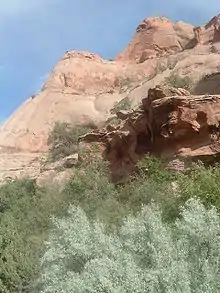Grandstaff Canyon
Grandstaff Canyon (called Nigger Bill Canyon from the late 19th century until the 1960s, and Negro Bill Canyon until 2017) is a canyon in southern Grand County, Utah, United States. It is part of the Colorado River watershed. Its stream flows directly into the main channel of the Colorado River within Moab Canyon.



Description
A trailhead which gives hiking access into the canyon is located directly adjacent to Utah State Route 128 (SR‑128).[1] The trailhead is located about three miles (4.8 km) east of the junction of SR‑128 and U.S. Route 191. The Morning Glory Arch[2] is located in the canyon[3] about 2.5 miles (4.0 km) from the trailhead and has a length of 943 feet (287 m).
The canyon was named after William Grandstaff, a mixed-race cowboy, who prospected and ran cattle in the desert canyon in the late 1870s with a Canadian trapper named Frenchie. They took joint possession of the abandoned Elk Mountain Mission fort near Moab after 1877, and each controlled part of the Spanish Valley. Grandstaff fled the area in 1881 after being charged with bootlegging whiskey to the Indians.[4]
Until the 1960s, the canyon was named Nigger Bill Canyon.[5]
Renaming
In the wake of the 2015 Charleston church shooting, local councilwoman Mary McGann called for the renaming of the canyon to the more formal Grandstaff Canyon. Although the local NAACP chapter was behind its renaming in the 1960s, they opposed the further change to Grandstaff Canyon. Jeanetta Williams, president of the Salt Lake City NAACP chapter, said the name wasn't offensive and wanted the local council to focus on different issues of discrimination instead. However, in 2017 the U.S. Board on Geographic Names voted to have it renamed to Grandstaff Canyon.[6][7]
References
- Matson, Mike (April 2009). Moon Utah Camping: The Complete Guide to Tent and RV Camping. Avalon Travel Publishing. p. 250. ISBN 978-1-59880-195-8 – via Google Books.
- "Feature Detail Report for: Morning Glory Arch". United States Geological Survey. February 25, 1989. Retrieved November 28, 2017.
- "Zoom Earth satellite imagery". zoom.earth. Neave Interactive. Retrieved November 28, 2017.
- Van Cott, John W. (1990). Utah Place Names. Salt Lake City: University of Utah Press. pp. 271–272. ISBN 0-87480-345-4.
- McCombs, Brady (November 26, 2012). "Push on to rename 'Negro Bill Canyon' in Utah". Salt Lake Tribune. Associated Press. Retrieved March 29, 2015.
- "Utah's 'Negro Bill Canyon' renamed after years of debate". Houston Chronicle. October 12, 2017. Archived from the original on October 13, 2017. Retrieved October 13, 2017.
- Burr, Thomas (October 12, 2017). "Utah's Negro Bill Canyon renamed Grandstaff Canyon by federal board". Salt Lake Tribune. Retrieved October 13, 2017.
External links
| Wikimedia Commons has media related to Grandstaff Canyon. |